HDMI vs. DisplayPort: Which display interface reigns supreme? - sullivanwouniend1968
The HDMI audio frequency/video interface common is everywhere: TVs, set-top boxes, media streamers, Blu-ray players, A/V receivers, play consoles, camcorders, digital cameras, and even up a few smartphones. You'll also detect an HDMI output port in most consumer desktop and laptop computers, besides atomic number 3 an input port happening many all-in-one PCs, to enable a gaming console OR a set-pinnacle box Crataegus oxycantha use its internal display.
Given HDMI's ubiquity, you might have forgotten roughly the some other member sound/video standard: DisplayPort. Though you'll find it alongside HDMI on most late-model, high-end video cards, as considerably as in Macs and laptops marketed to business users, IT rarely appears in Windows PCs aimed at consumers. IT's also rare as hen's teeth in consumer electronics devices.
Both HDMI and DisplayPort can cede high-definition whole number video and high-closure audio from a source device to a display, so what's the difference and why might you wish DisplayPort when HDMI is and then common? And what does a future with burgeoning USB Type-C ports hold? We'll answer those questions and to a greater extent; but prototypal, the narration of how the two standards came to be, and which entities control them.
HDMI and DisplayPort origins
The HDMI (High Definition Multimedia User interface) stipulation was conceived in 2002 aside six consumer electronics giants: Hitachi, Panasonic, Philips, Silicon Image, Sony, and Toshiba. Today, HDMI Licensing, LLC, a wholly owned subsidiary company of Silicon Image, controls the specification, merely some 80-odd vendors are members of the HDMI Assembly. Member or not, manufacturers must pay a royalty for including HDMI in their products. They of feed, snuff it that price along to you.
The DisplayPort spec was improved aside, and remains under the moderate of VESA (the Video Electronics Standards Affiliation), a large pool of manufacturers ranging from AMD to ZIPS Corporation—nearly all of which also consist to the HDMI Forum. You've likely heard the name VESA in relationship to video earlier. Most TV manufacturers, for instance, adhere to the system's wall-mount standard.
DisplayPort debuted in 2006 as part of an effort to replace cardinal older standards used primarily for estimator displays: VGA (Video Artwork Array, an analog port 1st introduced in 1987) and DVI (Appendage Video Interface, introduced in 1999). DisplayPort is a royal line-free product, but that wasn't enough to overcome HDMI's quatern-yr momentum. Computers, with their shorter technology cycles and often greater reveal needs, were another matter.
Fun fact: Of the six companies responsible for the institution of HDMI, exclusive Hitachi and Philips are not also member companies of VESA.
HDMI and DisplayPort capabilities
HDMI, recently revised to translation 2.1, is capable of supporting bit rates adequate to 48Gbps. VESA even Sir Thomas More recently declared DisplayPort 2.0, which can handle unanalyzed throughput ascending to 80Gbps. At the time of this authorship, however, DisplayPort 2.0 had not been implemented in any devices; and HDMI 2.1, which makes many of its features optional, has been fully adopted in relatively few rattling-existence products. Current Samsung 8K TVs, for example, purpose HDMI 2.1's increased telecasting bandwidth, but they don't funding eARC for sound ravish. LG's new 8K OLED implements both. This scenario is last to change for a while.
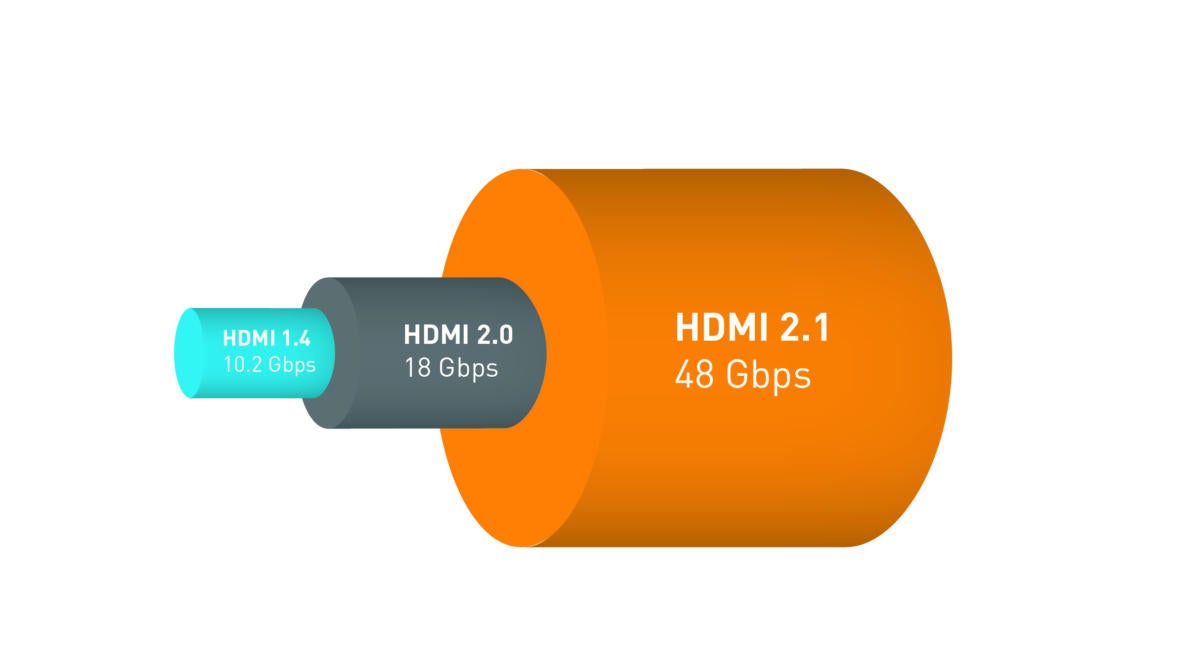 HDMI Forum
HDMI Forum HDMI 2.1's wider pipe allows higher-resolution video and audio than previous versions.
Arsenic you pot see from the images above and to a lower place, HDMI and DisplayPort both have widened their pipes tremendously over the years.
 DisplayPort Org
DisplayPort Org DisplayPort's bandwidth has increased importantly over the years.
HDMI and DisplayPort are similar when it comes to practical applications, and the industry mostly views them as complimentary standards. Indeed, HDMI 2.1 offers VESA's Display Stream Compression. DisplayPort's naked specs are for certain more impressive, but HDMI's capabilities stimulate always been much adequate for the mainstream A/V market.
Note that both standards can drive elderly display types, both via adapters and adapter cables: HDMI to VGA and DVI; and DisplayPort to VGA, DVI, and HDMI. Both standards are also backward compatible, decreasing aft to the oldest revise used in a connector.
Present is a graph showing prima features and specs for each standard. Click to expand to a readable size.
 IDG
IDG Definitions: bpp is bits per pixel. 24bpp/3 subpixels = 8-bit color; 30bpp/3 = 10-act color. 4:4:4 way full color and luminance data is being delivered. 60Hz and 60fps are equivalent. HDMI supports a second video stream, which can Be used for a second presentation or for picture-in-picture/picture-by-picture, only it's rarely implemented. The DisplayPort cable specification allows for power transmission on pin 20, but these days, only Thunderbolt 1 and 2 support power carriage.
HDMI and DisplayPort serve the synoptic things, but in very different shipway, and there are features unique to each. HDMI explicitly supports CEC (Consumer Electronics Control) for controlling entire A/V setups, and an HDMI cable terminate carry ethernet information. ethernet requires a purpose-built cable as described in Cables section to a lower place. DisplayPort supports CEC over an adjuvant channel, only it's rarely if ever implemented, delinquent simply to DisplayPort's faint footprint in the consumer electronics world.
Using multiple displays connected HDMI and DisplayPort
Probably the biggest practical difference betwixt the two standards is that DisplayPort arse drive four daisy-chained displays and HDMI keister cause just deuce, with implementations of the last mentioned being extremely scarce.
Notice that the 48Gbps per second and the 80Gbps quoted above are the unprocessed HDMI 2.1 and DisplayPort delivery speeds severally. DisplayPort 2.0 has four lanes that can deliver approximately 77.37Gbps (19.34Gbps per lane) of actual data, while DisplayPort 1.4a can have 32.4Gbps (6.48Gbps per lane); HDMI 2.0 delivers 14.4Gbps; and the sr. HDMI 2.1 offers 42.6Gbps.
To determine if a resolving power will work, enjoyment the following calculation and comparison it to the available bandwidth: Naiant resolution * straight-backed resolving power * bits per pel (i.e., color depth) * frames per sec. For object lesson: 3840 * 2160 (4K UHD resolution) * 24bpp (8-bit color depth) * 60fps (review rate).
Divide the standardised's total data charge per unit by your result to see how many displays you can employ at that resolution with DisplayPort. There's a handy calculator at KV Audio, although IT misidentifies bits per cell (fill in-picture element) as bits per pixel in the color astuteness branch of knowledg. (8bpc = 24bpp, etc.). Just to generate you an idea, DisplayPort 1.4a and 2.0 can drive 4 daisychained 4K UHD displays with 8-bit color deepness and a 60Hz refresh rate. You'll take the newer common for 10-bit (30bpp) color—or use DSC (Display Stream Compression).
Instead, use the graph from the HDMI Forum exhibit resolutions and their underestimate bandwidth. These correlate rough to DisplayPort.
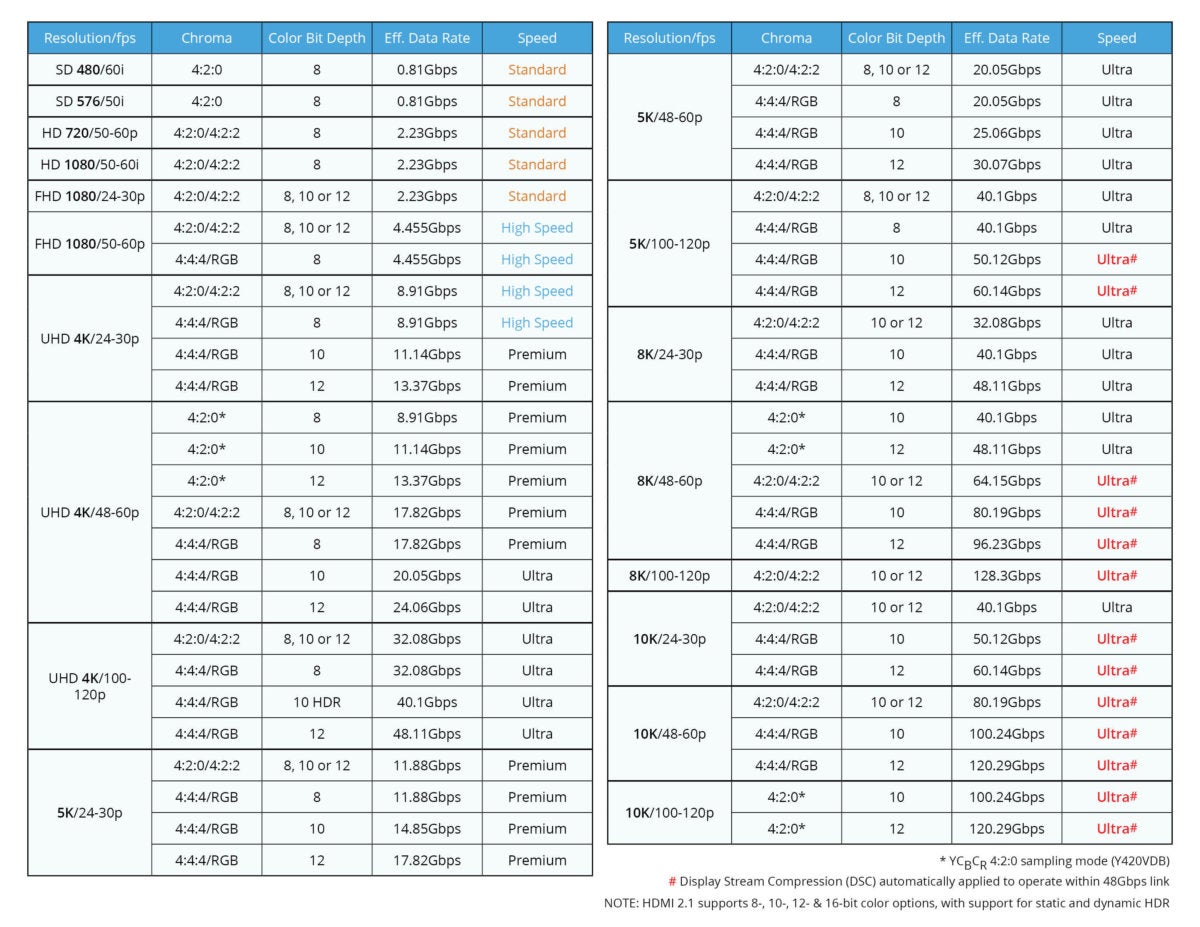 HDMI Licensing
HDMI Licensing This chart is for HDMI, just the bandwidths also translate to DisplayPort.
HDR Support on HDMI and DisplayPort
Both standards support HDR (High Dynamic Range), with its wider brightness and color gamuts, but HDMI 2.0x sole supports static metadata (HDR10), while HDMI 2.1 and DisplayPort 1.4a/2.0 both support high-octane metadata (HDR10+, etc).
Static metadata agency TV adjustment-for-satisfied data is sent once at that start of a television. Dynamic metadata means adjustment data is dispatched throughout the television and allows finer adjustments. Dolby Vision is embedded into the experienced stream protocols and volition work with any recent version of both standards.
Audio frequency transmission connected HDMI and DisplayPort
HDMI and DisplayPort cover 192Hz/24-bit audio frequency, but with HDMI, that's exclusively over a single cable association. That's fine for high-resolution audio frequency buffs with an HD audio player and an A/V receiver. But to pass audio from a Television tuner or authorize IT done from a device attached to the TV to an A/V receiver, HDMI 1.4 and 2.0 use ARC (Audio Return Channel), which is limited to cardinal channels of 44.1Hz/16-number uncompressed audio.
Curve supports highly compressed 5.1 surround, just uncompressed 5.1 and 7.1 audio, as advantageously Eastern Samoa sample rates up to 192kHz/24-bit are now possible via HDMI 2.1's eARC (enhanced ARC) touchstone.
DisplayPort 1.4 and greater has no such issues and can conk uncompressed 7.1, 192Hz/24-bit sound audio to as many as four displays should you ever let the need for such a setup. Past versions supported this on only when a single display or receiver.
HDMI connectors
HDMI connectors have 19 pins and are most normally seen in three sizes: Type A (classic), Type C (mini), and Type D (little). Of these, Type A is what you'll find happening TVs, Blu-shaft players, soundbars, and some other large A/V components; Typecast C is often found along smaller devices, such as dash cams; and you'll typically chance A on phones and tablets. A fourth category of HDMI connector, Type E, is misused for automotive applications.
Most HDMI connectors rely on friction to stay in situ, although more or less vendors have developed proprietary locking mechanisms designed to preclude the cable from pulling loosen.
 HDMI Licensing LLC
HDMI Licensing LLC DisplayPort connectors
DisplayPort connectors bear 20 pins and are available in two sizes: DisplayPort and Mini DisplayPort (the latter is the embrasure of choice for Microsoft's Turn up In favou tablet, American Samoa well as Macs anterior to Apple's borrowing of USB Type-C/Thunderbolt 3). Find one along Amazon.
Interestingly, Intel's Bombshell 1and 2 interfaces use the Miniskirt DisplayPort connector for PCIe communications, merely it can function as a DisplayPort port Eastern Samoa well. Most rich-size DisplayPort connectors have a lockup mechanism, though the official specification does not require it.
HDMI cables explained
One thing to bed about HDMI cables is that while in that location is a layout specification (i.e., the number or wires, pin connections, etc.), and the cable type is family 3 (twisted pairs with no shielding required), there isn't a specification for the materials old in the cable's construction. Hence, HDMI signals tin can also be runnel terminated CAT5 or CAT6 cable (with a upper limit resolution of 1080p), or over transmission overseas telegram, reported to HDMI Licensing LLC. Active cables with signal-booster circuitry, meanwhile, can be longer and thinner (capable 130 feet, compared to 65 feet for peaceful cables). Thinner cables are less likely to fail when forced to make hard bends.
That's all capital, merely it does muddy the waters a bit for users as to which cables will work with which devices. There is a testing and certification programme if you want a logotype, but an overbuilt cable from the early years testament quite belik work with the more recent standards; i.e., higher resolutions and emblazon depths.
There are currently three bandwidth standards and Word you power see, with a variant of for each one that re-tasks cardinal wires to run ethernet. That's including the new Ultra cables from the HDMI 2.1 specification.
- Standard HDMI Cable: Provides sufficient bandwidth for only 720p and 1080i resolution video. The ethernet variant can carry 100Mbps.
- High Speed HDMI Cable: These are good for adequate to 2160p (4K or 4K UHD), but only at a 24Hz refresh rate. Again, the ethernet variant carries 100Mbps.
- Ultra High Zip HDMI Cable: These cables are capable of carrying HDMI 2.1's full 48Gbps, which is good for 8K, 8K UHD, as healthy as flavors of 10K if the video is tight. Every bit deuce-ac wires throw been re-tasked, this power institutionalize some lesser cables to the bench. The ethernet cable different clay at 100Mbps, according to the HDMI Assembly's feature remit.
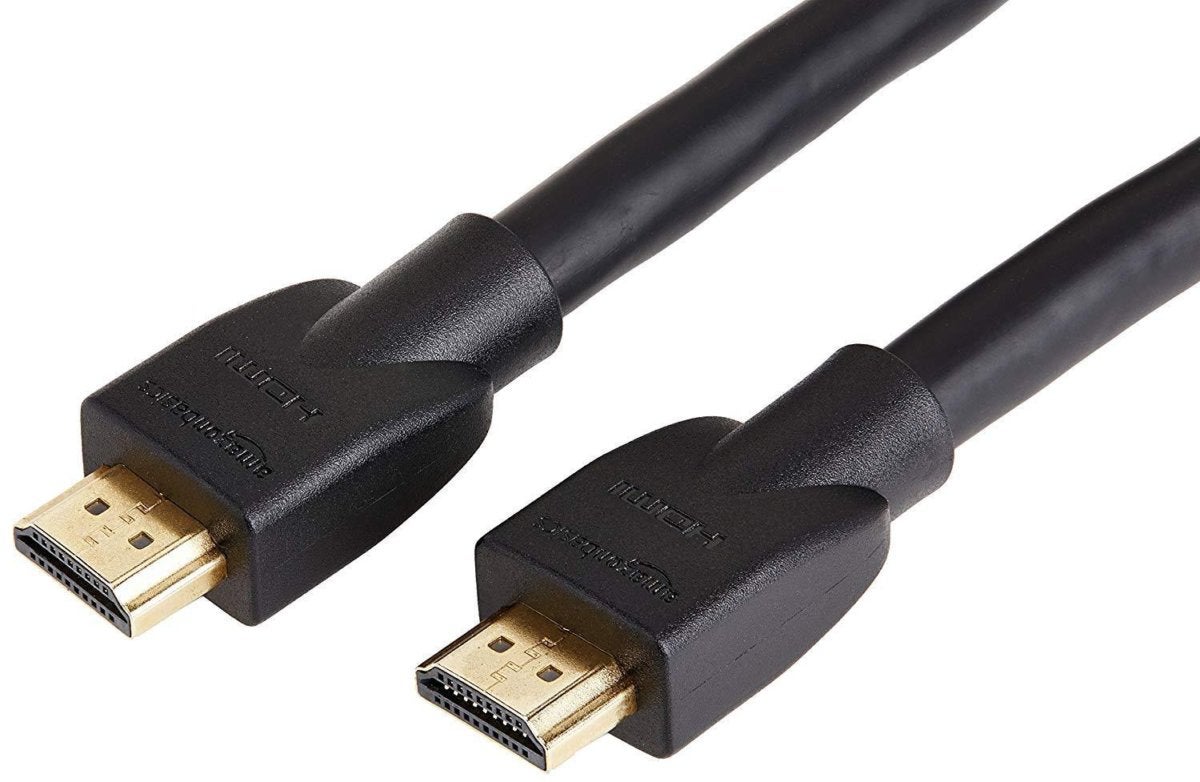 Amazon River
Amazon River If your current cables get into't pass muster, buy replacements that meet the specification of the video resolve you intend to watch. Given reasonably good fles quality, many cables you now own will function ticket, just as you step to the fore from 720 to 1080 to 2160 (4K UHD) to 4320 (8K UHD).
We've used whatsoever number of HDMI cables, from many eras, without encountering any issues, including passive 25-footers carrying 4K UHD signals. That aforesaid, 8K might be different; or it might not. The upshot is that you should try the cables you own with your new devices, and only upgrade them if you footrace into problems.
DisplayPort cables explained
The level connected DisplayPort cables is a bit simpler in that there's uncomparable basic 5-meter (16 feet) cable design, and only two connectors: full and miniskirt; but As with HDMI, there are types and certification levels, as shown below.
- RBR DisplayPort cable (Ablated Bit Rate) 6.48Gbps (DisplayPort 1.0)
- Standard DisplayPort telegraph for HBR (Falsetto Bit Rate) 10.80Gbps and HBR2 (Lofty Bit Rate 2) 21.60Gbps
- DP8K cable for HBR3 (Nasal Bit Rate 3) 32.40Gbps (DisplayPort 1.3) and UHBR 10 (Ultra High Bit Rate 10) 40Gbps (DisplayPort 2.0)
Again, try your cable before you opt for something more big-ticket, whether IT has a mark or not. As wel, practical experience has shown that VESA's length specs are very conservative, contingent on resolution.
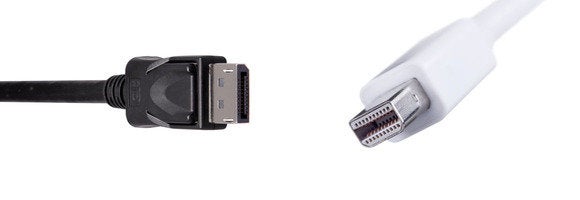
Active fuzz DisplayPort cables draw power from the DisplayPort connector to operate on a signal amplifier embedded in the connector, and they can be substantially longer than passive cables.
Pin 20 in the DisplayPort spec is used for power over Thunderbolt, and was originally used with DisplayPort. Withal, information technology caused issues and was dropped from cables if not the connectors. That's the reason there are both Thunderclap and DisplayPort cables, rather than one type. Aged non-secure DisplayPort cables might have trap 20 neighboring. Equal careful with them, or betray them to someone with a Thunderbolt setup.
As to cable television lengths, the shortest you can get off with is the optimal. Active will beryllium required for really prospicient runs, but what you'll detect for sale at this taper off in maturation is a good indication of what's possible. Over again, the story with the modish standards has yet to be written, so after trying your old cables, buy up one with the seize logotype.
Is it a Type-C future?
When USB 3.1 showed upbound, a corollary stock for a new, updated connection was as wel introduced: USB Type-C, or as it's now formally titled—USB-C. The USB Implementers Assembly hind end call it what it wants, but the world at large now refers to it simply as Type-C. That's a good thing A a feature called "Alternate Mode" allows Type-C ports and cables to be used for other transmit protocols, including Bombshell, DisplayPort, MHL (Mobile High-definition Colligate, for mobile phone phones), VirtualLink (for VR headsets), and HDMI.
Thusly far, still, alternate modality is being used almost entirely for Thunderbolt (which embeds DisplayPort), DisplayPort, and naturally USB. Elevation-mode HDMI, though for sale, has yet to show off up en bloc.
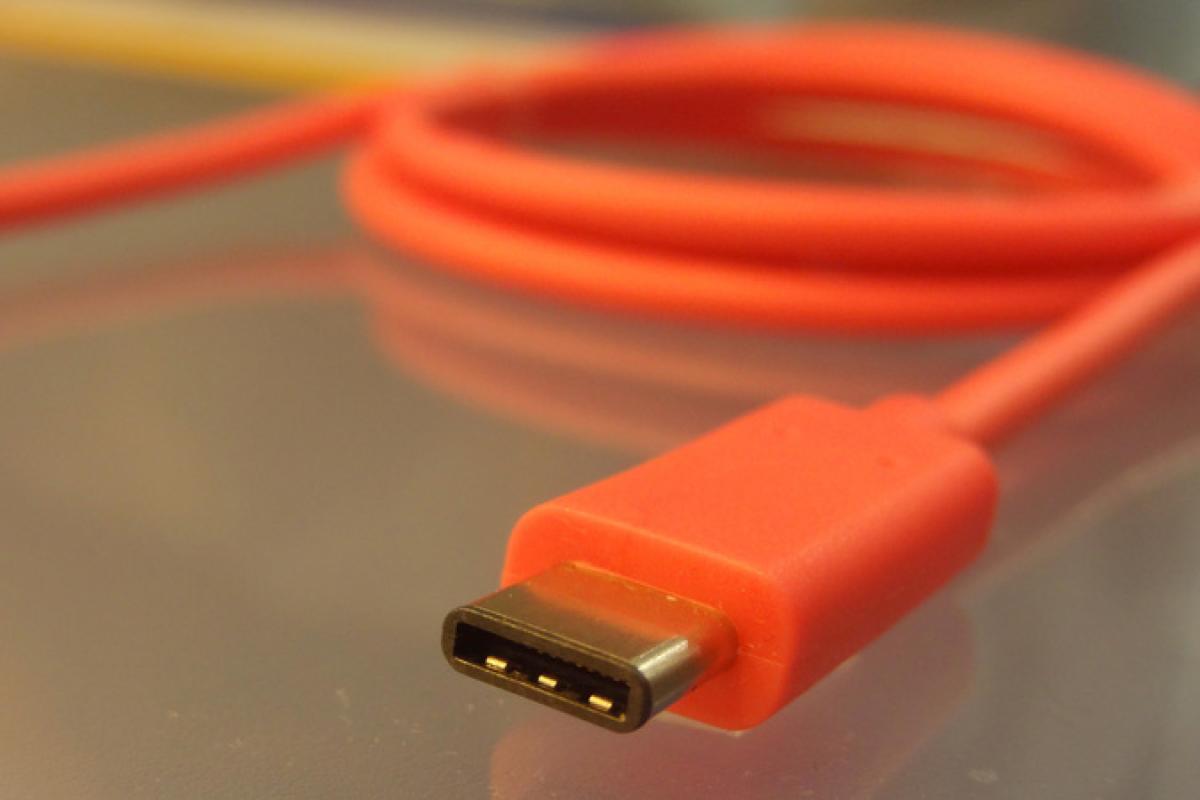 gam Shah/IDG
gam Shah/IDG USB-C features an alternate way that allows the economic consumption of alternative transport protocols, such as DisplayPort and HDMI.
Captains of industry rarely play whizz of humanity; nonetheless, if the stars align, and they all wake up in a particularly good mood incomparable day, maybe complete your consumer electronics and computer vendors will determine happening a single cable type. That would be nice for both your pocketbook and the the environment.
Note that DisplayPort 2.0 and HDMI 2.1 mightiness be constrained, equally the latest USB spec allows for "only when" 40Gbps of bandwidth. Darn, and here we were feeling all loving and fuzzy.
Which display interface is scoop right now?
Technically, DisplayPort sounds like HDMI's awe-inspiring Big Brother, but HDMI can easily stand up up for itself in average practical applications. And, atomic number 3 we've already acuate out, HDMI had a quaternity-class head start. If you'Ra talking TVs, A/V receivers, and the like, as well As budget computing, HDMI is what you're going get 99.9 percent of the time, and it's more than adequate.
On the other hand, if you're looking to create a robust multi-monitor setup, you're talking DisplayPort. That generally requires a discrete graphics poster or a higher-priced computer; but with the growing acceptance of USB Type-C ports as a regulation, hopefully DisplayPort will become significantly more widespread altogether sectors of the commercialise.
Source: https://www.pcworld.com/article/457147/hdmi-vs-displayport-which-display-interface-reigns-supreme.html
Posted by: sullivanwouniend1968.blogspot.com


0 Response to "HDMI vs. DisplayPort: Which display interface reigns supreme? - sullivanwouniend1968"
Post a Comment